Recent Mold Remediation Posts
Clearing the Air: Debunking Common Misconceptions About Cleaning Mold
6/23/2023 (Permalink)
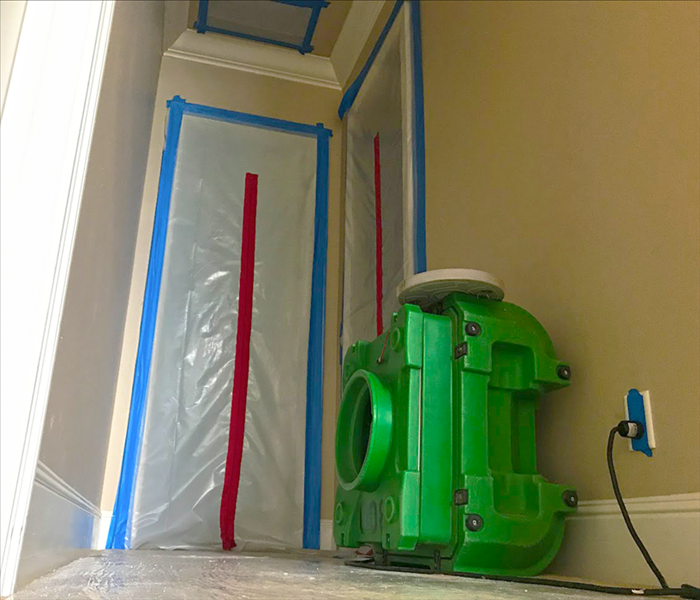 Disturbing mold can cause the mold to quickly produce a larger amount of airborne spores. Remediation experts contain the area beforehand.
Disturbing mold can cause the mold to quickly produce a larger amount of airborne spores. Remediation experts contain the area beforehand.
Mold growth is a common concern for both residential and commercial properties. It thrives in damp and humid environments, posing potential risks to structures and compromising indoor air quality. However, there are several misconceptions surrounding the cleaning and remediation of mold. In this article, we aim to debunk these myths, shed light on what indoor mold is, explore the causes of its growth, discuss common mold types, and clarify the roles of licensed mold assessors and remediation companies.
Understanding Indoor Mold:
Indoor mold refers to fungal growth that occurs within buildings, often in areas with excessive moisture and inadequate ventilation. It can manifest in various forms, including black, green, or white patches on surfaces, musty odors, and visible signs of water damage. Mold reproduces through spores, which can become airborne and spread throughout a property, potentially leading to further contamination if not addressed promptly.
Common Causes of Mold Growth:
Moisture Intrusion: Leaky roofs, plumbing issues, or poor insulation can introduce moisture into buildings, creating an ideal environment for mold growth.
Humidity: High humidity levels, especially in areas with limited airflow, contribute to moisture buildup and create a conducive atmosphere for mold to thrive.
Condensation: Improper ventilation, particularly in bathrooms, kitchens, and basements, can cause condensation on surfaces, promoting mold growth over time.
Flooding or Water Damage: Untreated water intrusion from floods, leaks, or burst pipes can create significant mold problems if not properly remediated.
Debunking Common Mold Cleaning Myths:
Myth 1: Bleach Kills Mold Completely: Contrary to popular belief, bleach is not an effective long-term solution for mold remediation. While it can help remove mold stains temporarily, it does not address the underlying issue or prevent regrowth. Professional mold remediation methods involve comprehensive removal and thorough cleaning of affected areas.
Myth 2: DIY Methods are Sufficient: While small mold problems might seem manageable, it's essential to understand that visible mold is often an indication of a more extensive issue hidden within walls, ceilings, or other concealed spaces. DIY attempts may not fully eradicate the problem, leading to recurring mold growth and potential structural damage. Professional assessment and remediation are crucial for thorough and lasting results.
Common Indoor Mold Types:
Stachybotrys Chartarum (Black Mold): This greenish-black mold is often associated with water-damaged materials and has gained notoriety with the public. Prompt remediation is essential when dealing with this type of mold.
Aspergillus: Aspergillus mold can come in various colors and is commonly found in HVAC systems, damp areas, and improperly stored food. Some species of Aspergillus can produce mycotoxins, making professional remediation necessary.
Cladosporium: Cladosporium is a widespread mold found both indoors and outdoors. It can grow on damp surfaces, such as carpets, fabrics, and wood, and is known to trigger allergies and respiratory issues in susceptible individuals.
The Role of Licensed Mold Assessors and Remediation Companies:
Licensed mold assessors conduct thorough inspections and testing to identify the presence of mold, determine the extent of contamination, and assess potential causes. They provide detailed reports and recommendations, guiding property owners in making informed decisions regarding remediation strategies.
Licensed mold remediation companies specialize in safely and effectively removing mold from affected areas. They employ industry-standard protocols, such as containment measures, air filtration, proper disposal of contaminated materials, and the use of specialized cleaning agents to ensure thorough remediation.
The State of Florida does not allow a single company to hold both an assessor's and a remediator's license. This is to help prevent foul play with the potential conflict of interest having both licenses could lead to. Be wary of companies claiming to do both sides of a mold job. A professional mold assessor will create a detailed protocol on how your specific mold situation should be remediated and a professional remediation company will request that protocol before performing any work to ensure the problem is handled correctly with the least possible chance of returning growth.
Conclusion:
Clearing up misconceptions surrounding mold cleaning is crucial for effectively addressing mold
Why an Inspection for Mold is Crucial When You Suspect It
9/30/2021 (Permalink)
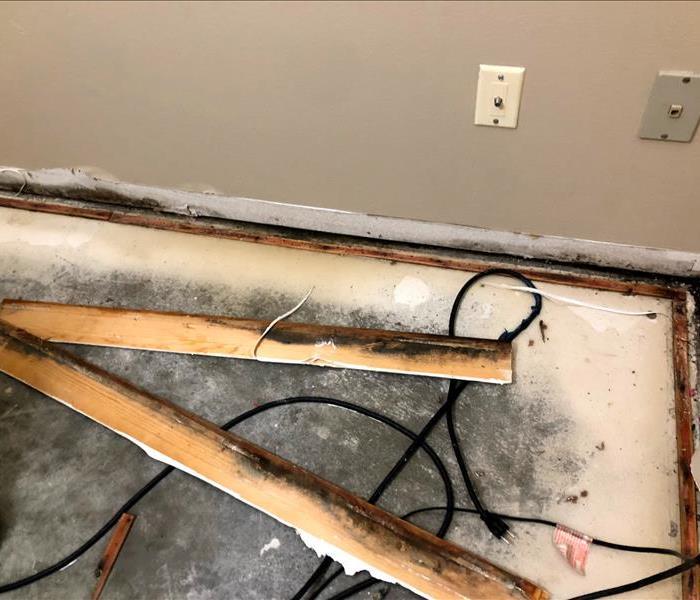 Many times, mold will remain hidden from the human eye. However, even when it is visible, an inspection for mold will tell you what your eyes cannot.
Many times, mold will remain hidden from the human eye. However, even when it is visible, an inspection for mold will tell you what your eyes cannot.
Contrary to popular belief, molds are a natural, helpful aspect of our environment!
Environmentally, certain molds can be quite helpful—for instance, blue cheese and penicillin. Some wood molds, such as Ophiostoma, are harmless to the building structures or their occupants. And so, a mold inspection for this form of mold would be unnecessary and costly.
Still, there are many more mold strains that can wreak havoc on your house and health. Some common examples include Aspergillus, which can affect people with severe allergy issues. Thus, if you're suspicious of mold, be sure to contact an expert mold remediation company as soon as possible. Your health and that of your friends, or family could be dependent on it.
Do you need an expert inspection for mold?
Fear of "black mold" infiltrating their houses and causing health and structural issues is quite common in Florida. Yet, we cannot deem all black mold "hazardous" based on its color.
Mold spores are always present in Florida homes; they are everywhere in Florida, and it's hard to keep them out. The issue comes when indoor air contains more mold spores than outdoor air.
You should call a mold inspector:
- If you have been suffering from severe allergies in your home or business.
- When there is no visible mold but a strange odor is present. Inspections for mold and mold tests can disclose whether or not mold is prevalent in this area.
- And lastly, if you've been experiencing plumbing or water damage concerns and suspect widespread mold behind the walls or in the air.
If you suspect mold in your Florida home, call a certified mold inspector right away to test the interior air quality and confirm the presence of mold.
How Inspectors Conduct the Mold Testing
Environmentalists specialize in performing IAQ (Indoor Air Quality) or MAS (Mold Air Sampling) tests. The purpose of this test is to identify irritants or probable mold strains present in your home or commercial building.
As we mentioned previously, despite its dark hue, not all mold is dangerous to black mold. A visual assessment alone cannot assess a mold growth's threat. Only mold testing can determine the mold strain in your home.
An inspection for mold will also look for historical mold growths that may reactivate or areas with signs of moisture that may contribute to future mold issues.
Then, the inspector will forward any samples taken during the inspection for molds or mold testing to a qualified lab for analysis and identification. In this manner, they can determine the exact nature of your mold issue.
One common technique employed in identification includes thermal imaging. It identifies water that could contribute to mold growth. If you have a musty odor but no recent water damage, thermal imaging can find a concealed leak behind your walls that generates mold growth.
A mold inspection usually follows precise guidelines to measure indoor air quality in Florida accurately. Reputable mold testing companies also write a written protocol that remediation companies like SERVPRO of Winter Park use for properly removing the mold.
Don't Get Tempted to Purchase A DIY Mold Test Kit
As you become more aware of the dangers of mold, you may get tempted to use a DIY mold test kit. Indeed, these kits are available over-the-counter and are gaining popularity due to their ease and perceived value. Sadly, many of them are rip-offs. Here's why you shouldn't buy them.
First, their results aren't as straightforward as you may think. Manufacturers of over-the-counter products want you to feel that their tests are simple. However, you still need an expert to interpret the results.
Secondly, the US Government mandates that only professionals should do the sampling. Professionals have the experience and understanding to develop and conduct mold sampling. Amateurs produce more false positives and negatives.
Thirdly, these kits are impractical when one cannot see the mold. One of the most common reasons to test for mold is when you can't see it but smell it. However, over-the-counter mold test kits only work if you have visible mold in your home — they can't detect if that musty scent is mold.
Further, these kits almost always identify mold, whether it's an issue or not. Millions of mold spores swarm the air, looking for a place to live and flourish. They will grow on a test kit petri dish whether or not it is an actual problem in your home. You can think you have a mold problem when you don't.
Lastly, DIYs don't tell you what caused the mold epidemic. A mold inspector must visually inspect the mold to ascertain its origin. Mold can form in your home due to leaking plumbing, lack of extraction vents, or drywall gaps. A mold test kit may indicate that you have mold in your house, but not why—a natural variety. You don't know if it's foundation or gutter concerns.
How Can SERVPRO Help?
Do you have a mold problem, or are you suspicious of one? Don't wait. Your health should be your priority. We have worked with many mold assessors in Central Florida and can put you in touch with a mold tester in your area. If testing shows a need for remediation, we have the experience and manpower to tackle the issue and help prevent it from coming back again.
Mold and Mildew Removal The Right Way
9/20/2021 (Permalink)
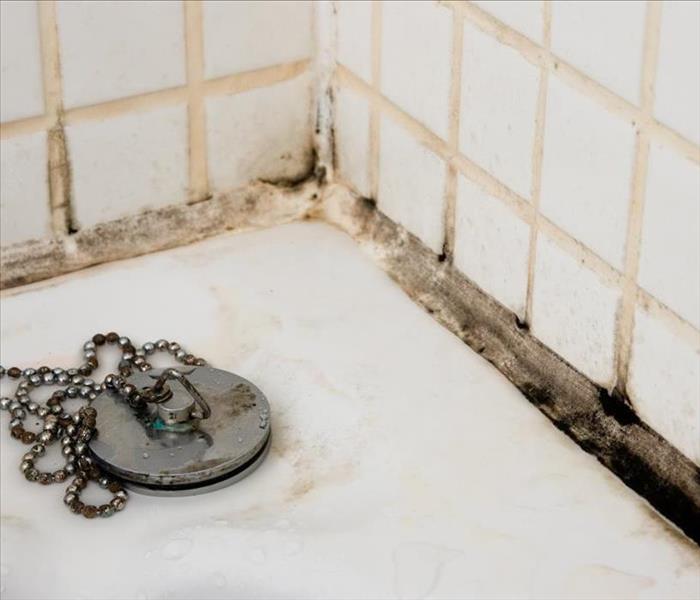 Mold and mildew on a non-porous surface such as tile can be cleaned with DIY methods. Deep spreading on porous surfaces requires a professional.
Mold and mildew on a non-porous surface such as tile can be cleaned with DIY methods. Deep spreading on porous surfaces requires a professional.
If you start seeing unsightly sots growing on your walls or smell musty odors, you might be dealing with a mold or mildew problem. To prevent mold issues, you need proper ventilation and avoid moisture by monitoring humidity indoors. But if it's too late and you already have a mold or mildew problem, you need to know how to clean. You can quickly get rid of mold or mildew on the affected areas, but it depends on how severe the effects are. Mold and mildew are basically the same; the only difference in the cleaning technique will be determined by the affected surfaces. Read on for mold and mildew removal essential tips.
When to Call a Professional
You are actually exposed to mold spores all the time, both outdoors and indoors, and that is mainly not a cause for concern. But when the right environment occurs and they start to grow and spread in your home, they may force you to call a professional. DIY is effective when the mold effects are not too severe. But there are instances when you need expert help with mold remediation. If you smell the mold but can't find the affected area, you may need to call a professional.
You also need to call a professional when you live with someone with severe allergies. Also, if the mold is creating structural problems that are way out of your skills, seek help. When you catch the mold early, you can use a cup of bleach, hydrogen peroxide, or baking soda to kill mold. But if it's a large colony of mold or mildew, you will need more aggressive chemicals and cleaning methods. That is when you should call a professional.
Mold and Mildew Removal on Different Surfaces
Cleaning non-porous and porous surfaces will have a slight difference. Learning how to remove mold on different surfaces will ensure your DIY cleaning is a success. You should always wear protective gloves, goggles, and a respirator.
Cleaning Mold off Grout and Tiles
The bathroom is very notorious when it comes to mold issues because of the humidity. For effective mildew removal, you need a solution of sixteen parts water and one part bleach. There are so many products in the market for cleaning, but water and chlorine bleach are equally effective.
After applying the solution to the affected surface, wait for fifteen to twenty minutes. You can then use a gentle bristled brush to scrub the place. Rinse the surface with clean water and dry it with a cloth. You should keep the area ventilated by opening the windows and allow to air dry.
Cleaning Mold off Fabric
You can wash mold away on washable fabric. If the clothing is still stained after washing, you will have to use oxygen, bleach, and hot water. Soak the cloth in a solution of oxygen bleach and water and leave it for several hours. If the fabric is dry clean only, you will have to take the material to professional cleaners. But first, brush the fabric to get rid of all the visible mold and mildew.
Cleaning Mold Off Wood
Wood surfaces, walls, or floors can be affected by mold and mildew. For easy mildew removal, you can start by vacuuming the area because it helps loosen the spores. Use warm water and mild liquid dish detergent to scrub the affected wooden area. You can use a bristled brush to scrub while constantly dipping it into the water and soap solution. This cleaning method will work best if the wood is painted or stained because the mold and mildew cannot penetrate the surface.
If the wood is not painted or stained, you will need vinegar. Mix equal parts of the warm water and vinegar and use a spray bottle to apply the solution to the affected wood surface. Let it sit for an hour before you wipe it off. Use a towel to ensure the wood is as dry as possible. Ensure you get rid of all the dirt to avoid mold stains. You can use borax when you don’t have vinegar.
Cleaning Mold off Furniture
Try to remove as much visible mold and mildew on the furniture’s surface as possible. Try using a damp cloth to wipe the surface before you start the cleaning. It will help you get rid of spores so that your work later becomes a little easier. Take dish soap or mild detergent soap and mix it with water. The water can be warm if you want; mix the solution until you have enough foam. You can use the solution to clean the furniture with a cloth or gentle brush.
It would be best to do furniture cleaning on a sunny day. Move your furniture outside and remove the mold and mildew outside. After cleaning, leave the furniture under the sun to dry, ensure it's completely dry before you move the furniture back inside. You can use a leather conditioner to treat the affected surfaces after cleaning. You may need to replace the furniture entirely if the mold is deeper into the cushions.
Cleaning Mold off Carpets
A substantial amount of mold and mildew on your wool or silk carpet may need professional cleaning. But if it's a small area that is affected, you can do it yourself. Every time you are using bleach to remove mildew, wear your protective gear. But if the carpet loses color, stay away from bleach. Isolate the carpet to ensure the mold will not spread to other parts. Use a vacuum or a stiff brush to remove visible mold spores.
Scrub the affected areas with cleaners and allow them to air dry. It may take a day or two for the carpet to dry completely. Once you are confident the affected area is not damp anymore, you can return the rug to where it was. To be safe, clean the floors thoroughly to avoid another mold issue with the carpet.
Cleaning Mold off Outdoor Surfaces
Patio stones, unpainted cement, and other outdoor surfaces can be affected by mold and mildew. When this happens, you will need a thorough scrubbing using chlorine bleach and water. Mix a gallon of water with at least one cup of bleach. Use a stiff brush because most of the outdoor surfaces are hard. You also need to be vigorous to avoid mold stain.
Chlorine bleach can harm your lawn, garden, or any plant. You have to be extra cautious when using bleach to clean outdoor surfaces. Cover any plants that may be affected before you clean the mold off. After scrubbing the surfaces with water and bleach, rinse them with clean water.
Conclusion
Mold and mildew issues can be very frustrating. You have to always keep an eye out if you want to win the war against mold. When you catch the issue early, you won't have to call a professional mold remover. Mold removal will be a breeze when you know how to handle different surfaces.
4 Telltale Signs of Mold in Your Home
4/26/2021 (Permalink)
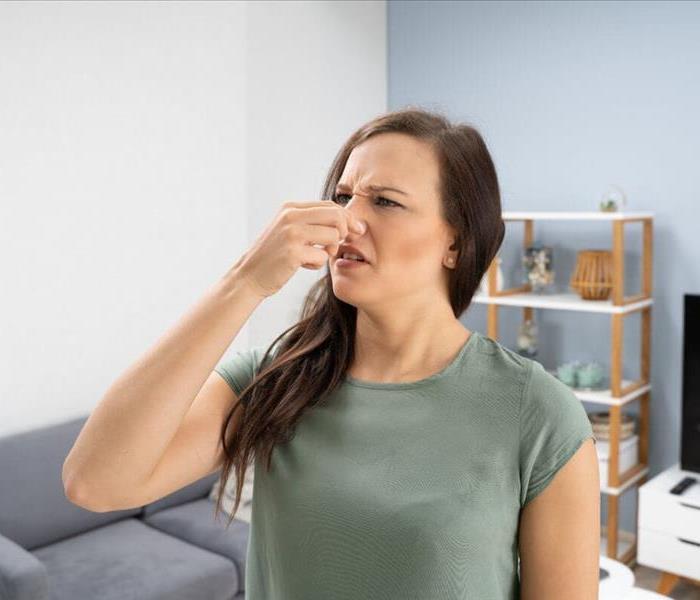 Aside from visible signs of mold in a property, there are non-visible signs such as foul and pungent odors.
Aside from visible signs of mold in a property, there are non-visible signs such as foul and pungent odors.
Mold isn’t always easy to pinpoint; its source can be hard to locate, and even more difficult to remove. What’s more, the presence of mold in a home is also linked to various health effects. Mold can be especially dangerous to children and adults alike. prolonged exposure can lead to short and long-term health effects. Dampness and mold together reduce air quality — especially indoors — and can damage the structural integrity of a home.
What Is Mold?
Mold is a fungal species that forms in damp or moist areas of a home, especially if a room or area has little natural light. Depending on your home, areas like ceiling tiles, basements, underneath sinks, wooden beams, and pipes can all carry mold species. Mold is typically noticeable by its fuzzy appearance — and often an unpleasant odor — spread by the dissemination of mold spores as the fungus matures.
Mold will spread simply by breaking down plant and animal materials in your home. It can be first introduced to a residential environment on shoes, clothing, family pets, or when the home contains a damp setting conducive for mold growth.
Types of mold
Certain types of mold are generally more likely to be found in homes. Consult the below information for some of the most common mold types, potentially affecting your house:
- Aspergillus mold is fairly common around the home, found most frequently in homes, on foods, and in air ventilation systems. Typically black on top with white or yellow hues underneath, this type of mold is rarely an issue for individuals with healthy immune systems.
- Cladosporium mold generally appears black or green — with a “pepper-like” texture — that can grow on toilets and other bathroom surfaces.
- Stachybotrys chartarum, commonly referred to as “black mold,” is toxic and can cause more serious effects. Recognizable by its dark green or blackish color, black mold can form in areas that maintain a damp or wet state for more extended periods. This often includes basements, window wells, flooded rooms, and dated wood.
- Trichoderma mold is identifiable by its white body and green patches and can grow quickly on wet surfaces like carpet, wallpaper, or neglected countertops. Over time, Trichoderma can break down even large-scale building materials and can yield more serious health effects.
Many types are mild and can be easily removed with common cleaning supplies. However, individuals who identify black mold in the home should take steps to immediately remove it before more serious health effects arise.
Warning Signs of Mold in Your House
Residents can identify several different types of mold around the house. While some types of mold are instantly visible and recognizable, others may require a review of your house’s history — and perhaps an assessment of how the mold has affected your physical health — before a professional can help identify it.
1. Smelling a Mold Odor
Often, mold’s presence in the home is identifiable by its distinct odor. If residents begin to identify a smell of decay — often described as “musty” or “meaty” — it’s a good indication that mold is nearby. In cases where a mold odor is more prevalent, professional odor removal and deodorization services can help you identify and eradicate the source of the smell.
2. Visible Mold Growth
Evident mold growth is also an obvious sign that there is an issue worth addressing. Keep in mind that mold won’t typically grow in well-lit areas of the home, where airflow and regular cleaning could limit its growth. Instead, mold is likely to grow in darker areas, like the regions behind or underneath furniture or stairs perfect for damp air. Even if you only identify slight mold growth, visible mold should be removed before the situation escalates further.
3. Water Issues
Water issues can also work to compound the mold situation you’re facing. Whether it’s signs of a past or present water concern — like a leak or active bubbling — water may mean that the growth of mold is not far behind.
From slight water stains, discoloration, or cracking, to fully flooded homes without sufficient aeration, water issues can yield mold far after leaks are addressed and floodwaters recede. Even if there are only trace signs of water present, homes without regular mold removal services can serve as a perfect breeding ground for mold to thrive in.
Homes subjected to flooding without subsequent water damage repair and restoration are also at risk for mold growth. To limit mold and other damage after residential flooding, remove vulnerable items from floors after mopping up excess water, and leave utilities and other electronics off until emergency help arrives to facilitate the water damage restoration process.
4. Mold Exposure
Mold exposure can lead to a wide variety of potential health effects. Many are mild, though certain mold types — or extended exposure to mold in the home — can yield more serious health effects.
How You Can Get Rid of Mold in Your House
Adopting a proactive approach to mold removal in your home can help limit the damage that mold has both to your house and to your health. Mold can be difficult to remove; leaving only a little mold in an isolated corner or behind a toilet can allow it to quickly grow back and resume its damage.
Residents should take steps to protect health during the mold removal process. Don’t disturb or blow on the mold, to prevent spores from spreading. If you have identified the growth of mild mold types in your home, they can usually be safely removed by applying a combination of water and one-quarter tablespoon of baking soda. Lemons — a natural antiseptic — can also be juiced and poured over the moldy area. After five minutes, aggressive scrubbing can remove both the lemon juice and the mold.
Especially for larger mold growths — and in cases of black mold — removal is often better left to the professionals. Don’t ignore the mold; instead, seek professional mold removal help for complete home restoration without any risk to your health, or the well-being of your family.
Tips for Preventing Mold
It’s not enough to successfully remove mold from your home; residents should take steps to actively prevent mold growth in the house, especially in potentially dark or damp locations where mold is most likely to grow.
Keeping mold from returning to your home is easier with the following tips:
- Ventilate the home properly, especially in rooms where mold is likely to grow.
- Keep spaces dry, and mop up thoroughly after cleaning surfaces with wet sanitation supplies.
- Periodically hire mold removal and remediation services for a full-scale home inspection that protects your house from mold invasion.
- Clean shower curtains and other areas where water gathers.
- Heat your home to prevent condensation from collecting on walls, doors, windows, counters, or other surfaces.
Allocating even a few minutes a day toward proactive mold prevention can help prevent serious future mold growth while protecting the health of all residents in the house.
5 Mold Remediation Don’ts to Avoid
5/7/2018 (Permalink)
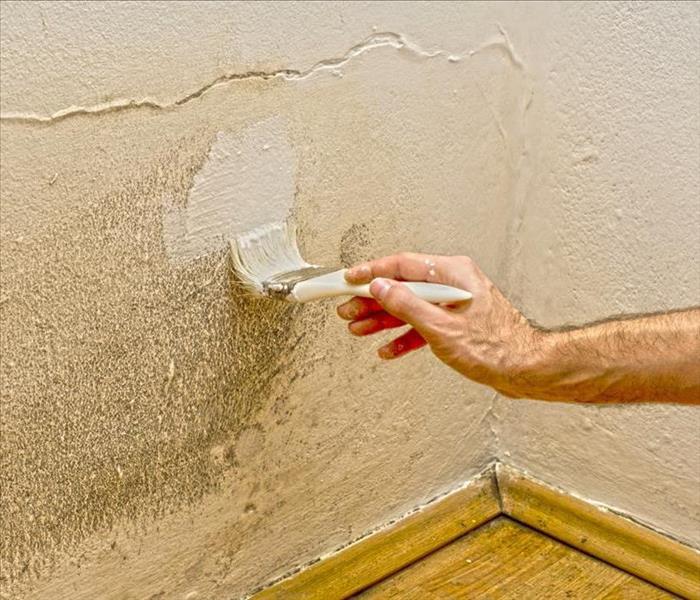 Painting over mold is looked at as the cheapest option for many property manager and homeowners but only limits your ability to visibly notice growth.
Painting over mold is looked at as the cheapest option for many property manager and homeowners but only limits your ability to visibly notice growth.
There are plenty of myths out there in regards to proper mold remediation and what actually works. New discoveries about mold are made all the time, and the recommended processes for treatment improves and adapts along with each discovery made. Because of this, predated information still exists and homeowners and property managers tend to use techniques that either make a mold situation worse or have no effect at all. Here are our top five mold remediation don’ts to avoid.
1. Bleach
The most common don’t when it comes to mold remediation is the use of bleach for the cleaning or removal of mold. While at one point The Occupational Safety and Health Administration (OSHA) recommended the use of chlorine bleach in mold abated, they were the first to retract their recommendation. The Environmental Protection Agency has since retracted their recommendation as well.
The truth when it comes to using chlorine bleach is that it actually CAN kill certain mold types (Aspergillus niger and Trichophyton mentagrophytes) when used on a non-porous surface. The main problems with this are that there are many other types of mold and remediation typically involves disinfecting wood and wood-based building materials, all of which are porous materials. Because the properties of chlorine bleach prevent it from soaking into wood-based materials, the bleach is not able to reach and affect the roots of the mold to stop it at its source. Mold membranes will recognize bleach as a threat, retreat further into the material to avoid it, and in some case, mold can even use the bleach as a fungal food to grow more rapidly. Yes, bleach can potentially make the problem worse! Be wary of any restoration company that recommends the use of bleach as a solution to your mold problems.
2. Vinegar
Another popular household item that is often used to deal with mold is vinegar. Vinegar is mildly acidic and actually can kill about 82% of mold species. However, when treating mold as a homeowner, you must be aware that visible mold growth in your property may not be the only area that is affected. Choosing this option runs the risk of missing additional mold growth within your property, leaving you unknowingly open to an increasingly worse mold situation. Seeking professional mold testing is always the best option for determining how bad your mold situation is, as well as determining the type of mold you are dealing with. In most cases, calling a professional mold remediation company is the best option, especially when the mold is widespread.
3. Scraping Off
One misconception is that you can remove mold by simply scraping it off. This is a big don’t for a few reasons. Mold is a living organism and disturbing it releases spores into the air which can potentially be breathed in. These released spores also cause the mold to contaminate other accessible areas of the property helping the mold to spread throughout. Scraping mold not only means a significantly higher bill for treating and removing it but also poses an increased health risk for all inhabitants of the property.
4. Ignoring Mold
Aside from making the decision to remediate on their own, many homeowners and property managers also make the decision to leave the mold as is. There are an enormous amount of risks involved when ignoring signs of mold. Mold that is exposed and left untreated is at high risk of being disturbed and spreading. Prolonged exposure to mold, visible or otherwise, can have different effects on people’s health. Another issue with leaving mold untreated is the structural damage that it can cause to your property. The longer that mold is ignored, the bigger your problems will be down the line across the board.
5. Painting Over
Due to either a lack of knowledge on mold or in some cases pure negligence, there are plenty of property managers, landlords and/or homeowners that choose to hide mold by painting over it. One of the biggest issues in property managers doing this is that it limits the inhabitants from quickly noticing the mold. Mold can eat through the majority of paints and become exposed again. By the time this happens, the mold growth is usually significantly worse. There are also mold resistant paints that are misconstrued as a viable option for painting over mold. These paints are intended to be used prior to mold growth on a clean surface to prevent the growth from happening. Using these paints will not take care of the issue and will only prevent you from noticing the problem get worse.
Local Mold Remediation Services
If you notice mold growth in your home or property, call the professionals here at SERVPRO of Winter Park. Our phone line 407-837-8990 is open 24/7 to assist you with your mold disaster.
5 Steps Used for Mold Remediation
3/12/2018 (Permalink)
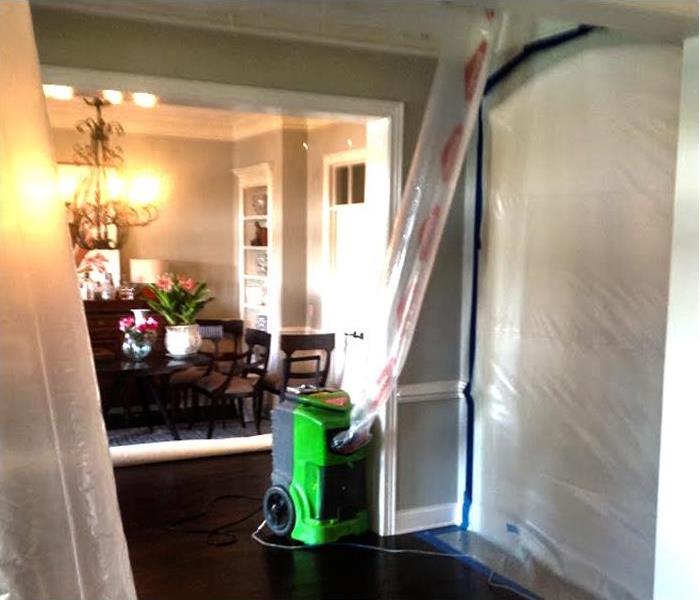 In this instance, water was still present in the affected area, so a dehumidifier forces hot air into the contained environment to continue drying.
In this instance, water was still present in the affected area, so a dehumidifier forces hot air into the contained environment to continue drying.
Mold in your Winter Park home or business can appear without warning and spread rapidly. While size and severity of a mold remediation job can vary, the 5 steps shared below are the foundation of the process we use every time.
Step 1: Mold Inspection
In Florida, the law states that the mold testing company cannot perform the actual remediation. We recommend having a mold assessment company take air quality samples in and outside of your property first. After receiving the test results from the samples and a protocol to perform an inspection, we then send a technician to thoroughly inspect and assess the damage to your property.
Our inspector checks for visible signs of the mold first and then proceeds to identify places where it may be hidden such as cabinets, baseboards, sheetrock, and under carpeting. Prior to remediation in areas over 10 square feet, it is important to have mold samples taken and tested.
Step 2: Mold Containment
The initial step is the most vital when beginning mold remediation. To ensure mold spores do not spread throughout your home, plastic barriers must be placed to separate affected and unaffected areas. We create a contained environment by systematically setting up a barrier and using negative air pressure. Negative air pressure creates a vacuum that forces the surrounding air that may contain mold spores into the contained environment. All entrances and exits of the area are completely sealed to prevent the spores from contaminating the rest of the property.
Step 3: Air Filtration
To achieve successful air filtration, we use powerful HEPA vacuums and air scrubbers. HEPA (High-Efficiency Particulate Air) vacuums work by forcing air through a fine mesh to trap harmful particles. Some of the particles captured by a HEPA filter include pollen, pet dander, dust mites, and tobacco smoke. Our technicians perform this step to capture mold spores that become airborne after removing drywall and similarly affected components of the property.
Step 4: Mold Removal
The mold removal step can vary in difficulty and length of time based on the extent of the damage and size of the affected area. Our technicians use antifungal and antimicrobial treatments such as Benefect, which is a plant-based and safe-to-use treatment. These treatments work to eliminate existing mold colonies and prevent new colonies from growing. In larger mold removal jobs, it is not uncommon for carpet and drywall to be removed as well, especially if they are infected with mold.
Step 5: Restoration
After removal, the next step is to clean and disinfect components of the property that have been affected by mold. Items such as curtains and furniture will be cleaned and deodorized. Repairs such as carpet replacement and painting are also made to restore the area. Because mold is a living organism that thrives inside of drywall, baseboards, cabinets, and clothing, it is necessary to remove them completely to eliminate the problem.
Your Local SERVPRO
SERVPRO of Winter Park is a family-owned business and knows what it takes to help you with your mold disaster. Give us a call to speak with a mold remediation expert and get the process started.
Contained Mold Removal Companies
2/9/2018 (Permalink)
 It is important to completely seal off the contaminated area.
It is important to completely seal off the contaminated area.
In a growing industry, options for mold removal companies are numerous. More options create the need for paying closer attention to quality. A major factor in your decision to hire a company should be whether or not the mold is removed in a contained environment. To better understand the importance of a contained environment, it helps to understand exactly how mold can spread.
How Mold Spreads
If left exposed, there are various ways for mold to spread throughout a home or building. Mold releases microscopic spores that can travel through vents, air currents, people or even pets. The spread of these spores is more likely to occur if the environment is not contained before removal.
Containing Mold
When creating a contained environment prior to mold removal, it is crucial to completely seal off the entire area that’s affected. The size of containment can vary based on the size of the contaminated area. Smaller mold issues typically require limited containment and can be sealed with a layer of polyethylene and duct tape. Larger issues require full containment. Full containment involves a sealing process using two layers of polyethylene, a barrier between the contaminated and non-contaminated areas, and an airlock chamber for the entry and exit.
Choosing the Right Professionals
Avoid any company that says containment of your mold issue is not a necessity. Mold can cause health effects so choosing a professional is in the best interest of all occupants of your home or commercial building. If you have a mold problem, you can contact a professional at SERVPRO of Winter Park for fast, reliable, and 24/7 service at (407) 678-5391.
 Disturbing mold can cause the mold to quickly produce a larger amount of airborne spores. Remediation experts contain the area beforehand.
Disturbing mold can cause the mold to quickly produce a larger amount of airborne spores. Remediation experts contain the area beforehand.





 24/7 Emergency Service
24/7 Emergency Service




